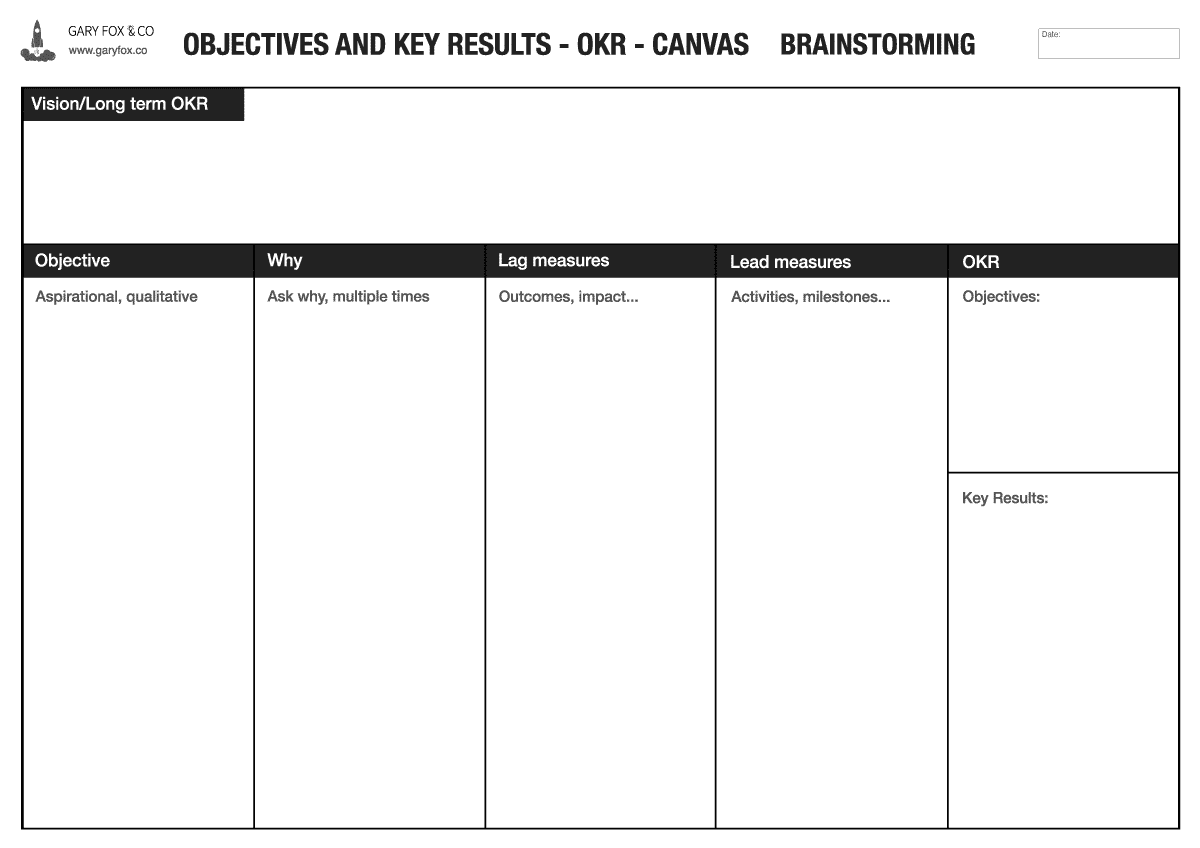The OKR Canvas Process
Set Company OKR
The company objectives are the first that need to be written by the executive/leadership team. They are usually written by the CEO and leadership team because they set the vision and mission. After this is done, all other levels can write their objectives in alignment with the company objectives and identify how they can contribute to it.
A company OKR is a big picture, the top-level focus for the entire company. This is where the initial brainstorming is involved and problem-solving OKR canvas comes in.
Set team OKR
The team objectives are written in two steps. For the first step, the leadership team conducts a meeting with their managers to write a draft of the team objectives. Often these are then divisional OKR’s.
Next, the cascade process begins as each manager conducts a private meeting with his team members to discuss and review all the objectives. By this way, everyone in the team is involved in the process and know exactly what their team have to do.
Team OKR’s define team priorities.
Set individual OKR
Personal OKR’s define what a team member needs to focus on. By the end of the OKR period, he/she can demonstrate what progress they have made.
To define individual objectives, the person involved discusses with his/her manager what is expected. It’s a negotiation with the manager and both have to agree with the defined list of objectives. It has to take into account their role, time, projects and other considerations.
Edit and improve all OKR
The last part of the OKR process is the review cycle. After individual objectives are defined, you can finalize team objectives by improving based on team members’ objectives.
After that, the top company objectives are modified to fit all of the different teams OKR’s.
This last stage is critical because each one defines the objectives at each level.
Evaluation
At the end of each reporting period, you evaluate your OKR in order to measure your accomplishment.
Success is based on a scoring system. The ideal score for achieving the key result is between 60 and 70%.
If you achieve less than that, it is not a sign of failure. Maybe the objective was too high, or other factors came into play.
While under-scoring throws into question the objective setting criteria, so too does over-scoring. If you achieve 100% of your objectives, then perhaps it was not ambitious enough, or you could have gone all out to hit it and worked long hours.
Each level presents its OKR results and analyzes how they were achieved. It’s important to learn from the past OKR data to improve the next.
If an objective has not been achieved, you can continue working on it in the next period, but only if it is still relevant. Culturally, the important part is to celebrate small and big wins. This encourages teams to continue to engage with the process.
Best Practices in Writing OKRs
Below are the OKR some best practices tips to follow:
For Objectives:
- Each team, department or individual should have 3-5 objectives.
- The objectives should be achieved in a certain time-frame (e.g. after one year or one quarter). It’s not an ongoing task.
- Objectives must be ambitious. In Google, a 70% success rate is considered a remarkable performance.
For Key Results:
- There are 3 key results per objective.
- Key results must be measurable.
- They are the steps needed to achieve an objective. Thus, attaining them is tantamount to achieving your objectives.
- They are not activities, but outcomes.
How To Use The OKR Canvas Templates
The OKR canvas is designed to help you through the basic steps of creating your team OKR’s.
There are three OKR canvas models:
- Executive team exploration
- Team brainstorming
- Team Board
1. OKR Canvas – Exploration
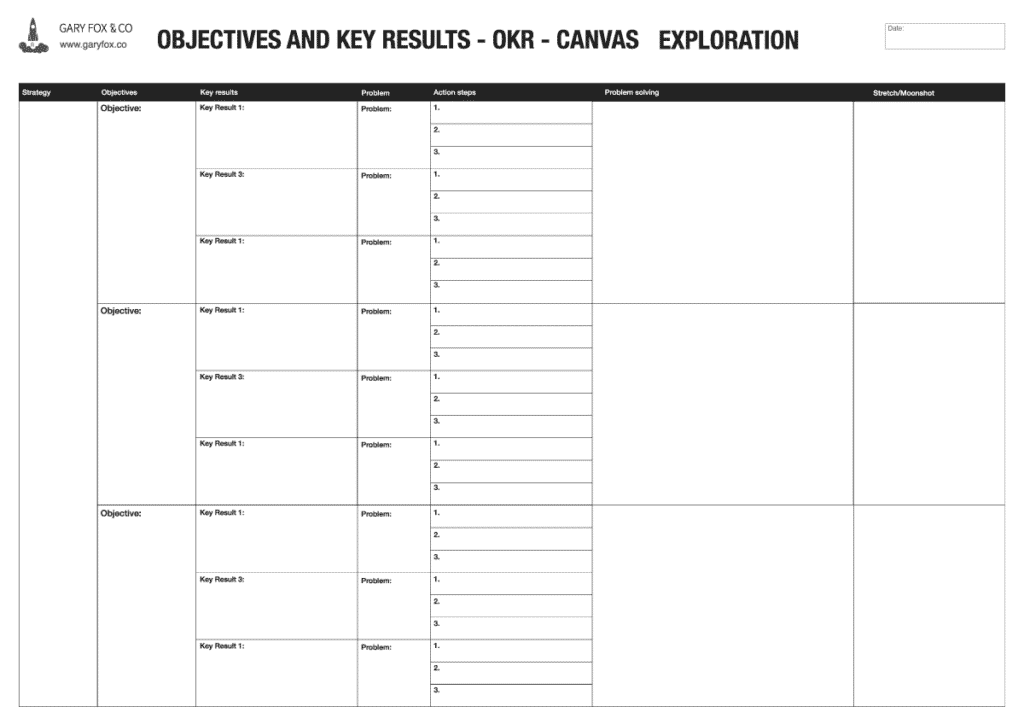
2. OKR Canvas – Brainstorming
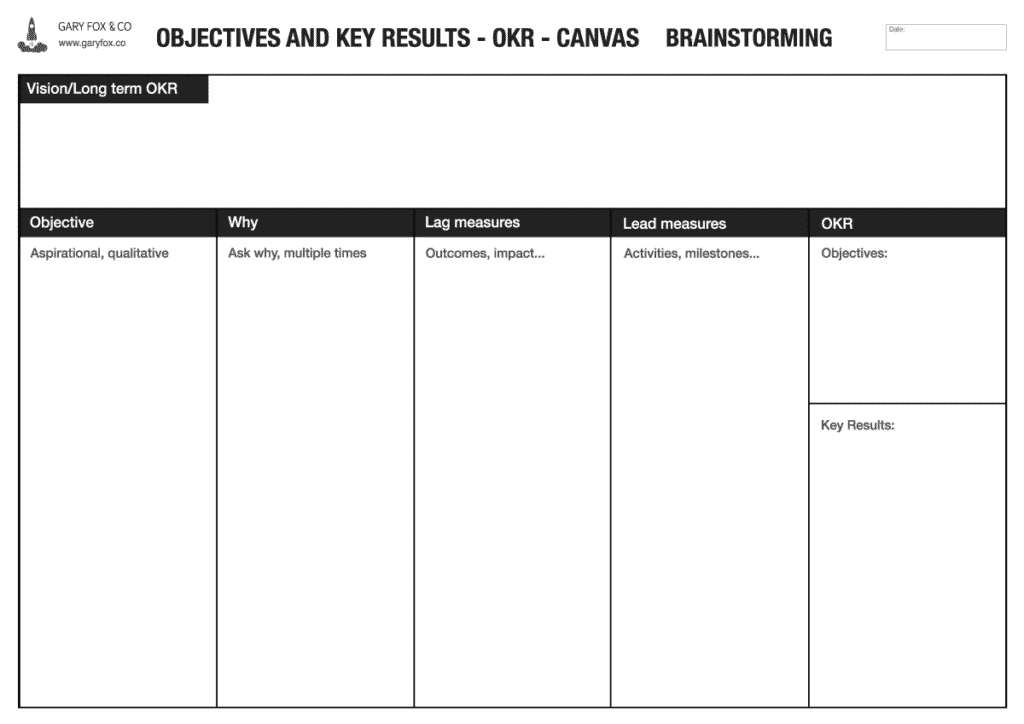
3. OKR Canvas – Team Board
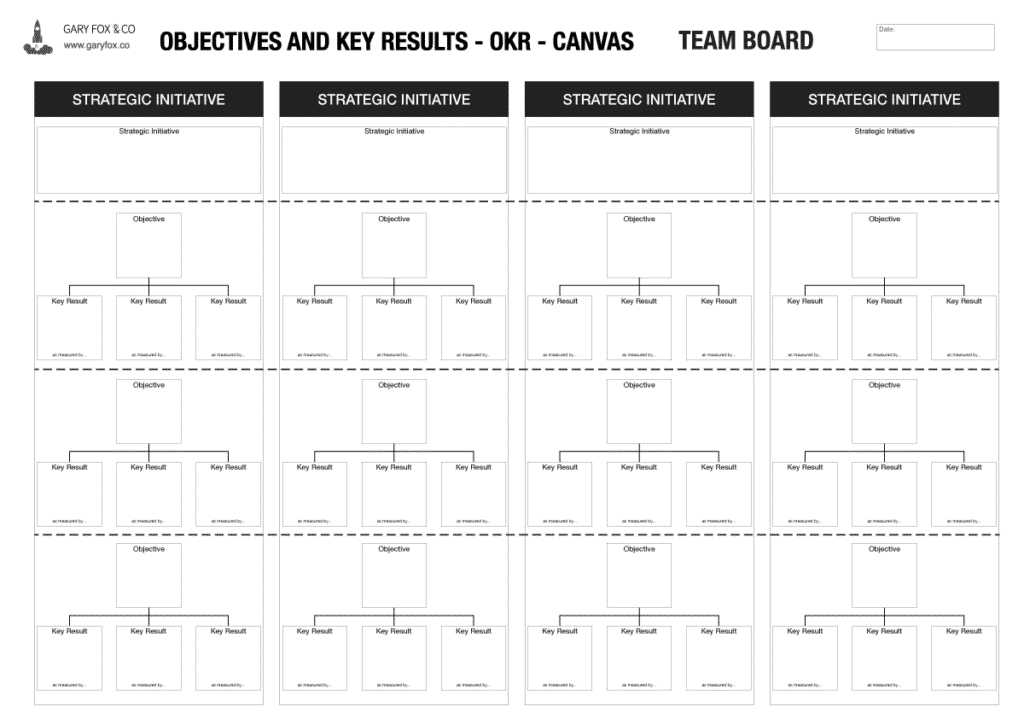
Step 1. set the stage
Introduce your team to the terminology and scoring system highlighter earlier. Remind them that OKRs are meant to be “uncomfortable”. They won’t be fired for setting an ambitious goal and missing it.
Does the whole concept make your team nervous? That’s not bad – but they must also still be motivated.
Listen to concerns but be firm. Reinforce the benefits and that this system is set across the company, everyone has the same challenges and opportunities.
Remind people that often they achieve their best results when they work outside their comfort zone. This is where real growth happens!
Step 2. choose your objectives
When writing your OKR, keep these two questions in mind:
- What I have to accomplish? The answer provides the objective.
- How am I going to get this done? The answers are the key results.
Pose the question “What are the most important impact(s) we need to make in the coming quarter?”
Spend a few minutes brainstorming ideas on sticky notes and posting them on the OKR canvas. Group similar ideas together. From there, distil your ideas down into 3 to 5 aspirational objectives.
Objectives should be high-level, qualitative statements that are aspirational – not tasks or granular outcomes.
Step 3. identify your key results
How do you measure progress toward a qualitative goal that is inherently un-measurable? You identify measurable outcomes that indicate you’ve achieved your objective.
For each objective, think about the results you would see (and can measure) if you reached it. Again, these are not tasks. These are result.
Wrong: “Ship feature X by the end of the quarter.”
Right: “Shipping feature X increases new user sign-ups by 10% this quarter.”
Assign each KR an owner on the team. If a KR will require collaboration with another team, great! Follow up with them afterwards and make sure they’re on board.
Step 4. identify your key results
Many people struggle to set key results for a qualitative goal. Often they think that qualitative objectives are unmeasurable. However, by focusing on outcomes it becomes easier.
For each objective, think about the results you would see (and can measure) if you reached it. Again, these are not tasks. These are results.
Wrong: “Improve customer experience by the end of the quarter.”
Right: “Lower customer service calls by X by end of quarter.”
Assign each key result an owner on the team. If a key result will require collaboration with another team, great! Follow up with them afterwards and make sure they’re on board.
Step 4. Ramp up your ambition
Review the objectives and key results you’ve built out and ask whether they’re ambitious enough. If you feel totally confident you can hit a key result, increase the target by approximately 30% and then create a plan mapping out how you will achieve it. If you’re not at all sure you’ll hit a key result target, it’s probably set just right.
Make sure the key results are articulated well and detailed. You want to be able to score them later on a sliding scale. Hard numbers and percentages work great here.
Also, consider whether you have too many or too few objectives and key results. I’ve found that for a single team of 7-9 people, three objectives with 3-4 ambitious key results each is about right.
Step 5. agree on next steps
Engage with your team throughout the process and at the end.
Ask your team if there are any loose ends to tie up before you go into execution mode. Any numbers to firm up? Objectives you should share with other teams? Or people from other teams to recruit as co-owners of a key results?
IT’s OK to have some open questions.
Schedule a follow-up session and task each Key Results owner with the task to update their key results prior to the session, so you that session with your OKRs baked and blessed.
Step 6. Scoring OKRs: monthly checkpoints
At the end of each month, check-in on how you’re tracking on your OKRs and give each key result a predicted end-of-quarter score. I.e., if you predict you’ll end the quarter with a score of .7 on a KR, then that’s your score for this month.
For example, let’s say your stretch key result is “a 10% increase in new user sign-ups this quarter”. Here’s how you’d score it based on how you’re tracking:
- if you’re tracking toward a 7% increase, you’d predict a score of 0.7
- if you’re tracking toward a 10% increase, you’d predict a score of 1.0
Include a bit of commentary as to how you came to that prediction and/or why it’s changed since last month.
Take the average score for all KRs to get your score for the corresponding objective.
Remember the idea behind scoring at regular intervals is to catch warning signs early and course-correct. This is not an exercise in arse-covering or justification. Most importantly, low-scoring OKRs are not punishable. Learn from them, and feed that wisdom into the coming month or next quarter’s OKRs.
Step 7. Reviewing OKRs
End the quarter give each key result a final score, and reflecting on your OKRs as a whole. Using a retrospective approach, pose some (or all) of these questions to your team:
- Were our objectives ambitious enough?
- Were our key results measurable? Did we know what our baseline was at the start of the quarter?
- Did we “set ’em and forget ’em”? If so, why?
- Were our OKRs aligned with the company’s broader strategies?
- Did they keep us focused on delivering value to customers?
- Did we feel connected to our OKRs?
- What have we learnt from this quarter? How do we lift the bar moving into the coming quarter?
4. OK Canvas ConsiDerations
LEADERSHIP TEAMS
OKRs work superbly for leadership teams, particularly when building out strategic plans. Adjust the time horizon from quarterly to yearly, and remember to not skimp on ambition.
MULTI-SESSION OKR SETTING
Hold a 30-minute session to choose objectives, as described above, and assign an owner to each one. Objective owners then engage their team and stakeholders to build out the key results. This works well if you need do some research before nailing down your KRs, or if your leadership team sets departmental objectives and supports individual teams to figure out the KRs they’ll contribute.
OFFSITE TO GET IT RIGHT
Extend this play to be a major component of your team’s next planning offsite.
CHANGE THE TIME HORIZON
Running a quarterly cadence might not hit the right notes for your team, perhaps a more frequent cadence is necessary. Or perhaps you’ve changed strategic direction mid-quarter, no worries. Tweak the time horizon as you need and don’t fall into default.
Follow-ups
Get the calendars organised early – Put time on the calendar for monthly scoring sessions, or set reminders for each owner to score their KRs. And schedule next quarter’s OKR setting session well in advance.
Do it all again – At the end of the quarter re-set the clock and do it all again, taking on-board lessons from the current quarter.
Bonus OKR Cheatsheet
FOr more information about OKR visit the article What is OKR.
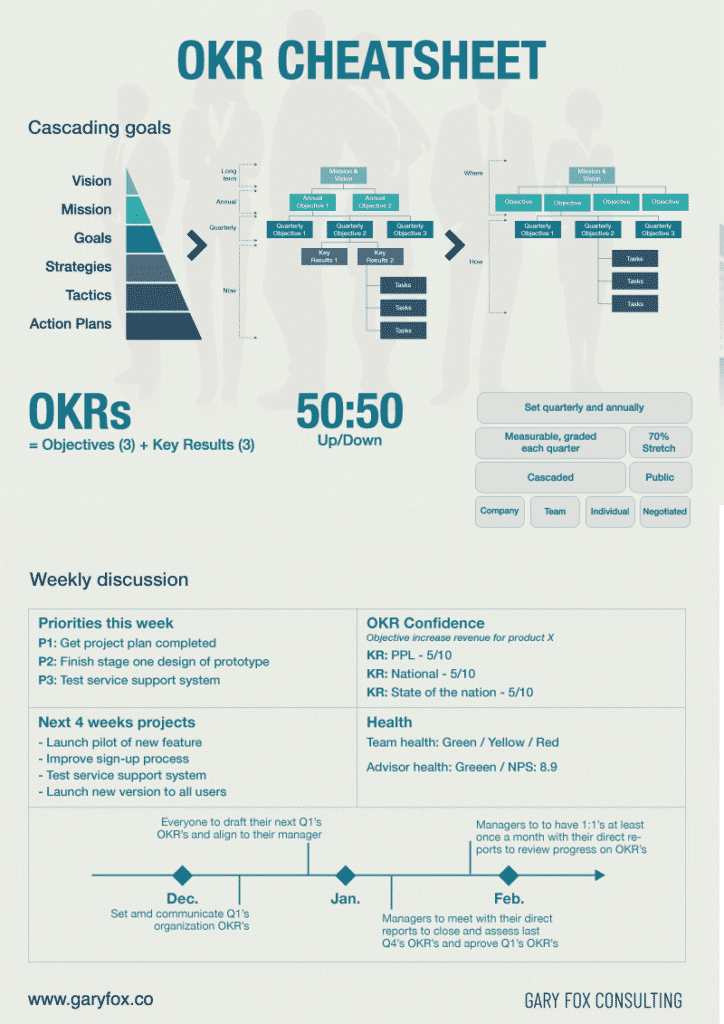
Mistakes to avoid
- Don’t force people to set OKR, or dictate their objectives.
- Set from the bottom up not top-down.
- Don’t set too many objectives or key results.
- Set measurable and quantitative key results.
- Your objectives must be time-bound.
- Don’t write tasks as key results.
- Don’t use OKR for a compensation program or a performance review system.
- Find the best method that matches your team.
- Most important, don’t implement an OKR and forget about it.
Now, you know all the steps needed to set OKR for your company. You have to find a suitable way to use it with your team. This is how you will make it work for your company.
Subscribe and Don’t Miss Out
Get ahead of the competition, use the latest winning strategy and innovation tips to get ahead.

More OKR Resources
